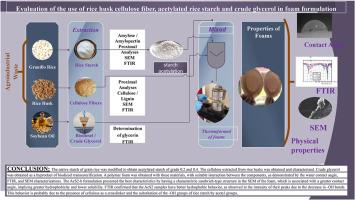评估泡沫配方中稻壳纤维素纤维、乙酰化大米淀粉和粗甘油的使用情况
IF 11
1区 农林科学
Q1 CHEMISTRY, APPLIED
引用次数: 0
摘要
本研究旨在评估泡沫配方中稻壳纤维素纤维、乙酰化大米淀粉和粗甘油的使用情况。之所以考虑这些化合物,是因为它们是大米产业和生物柴油产业的残留物,前者是全球消费量最大的谷物,后者是柴油的可再生替代燃料。这项研究的新颖之处在于认识到了这些原料(乙酰化大米淀粉、稻壳纤维素和粗甘油)在泡沫生产中的潜力。采用环保方法,只需少量化学试剂,即可获得乙酰化程度较低的淀粉。使用粒状大米提取淀粉,然后通过乙酰化对其进行改性。粗甘油作为大豆油酯交换反应的副产品,无需提纯即可获得。稻壳纤维素是使用非侵蚀性化学试剂脱木质后获得的。这些材料按不同比例混合,并加入乙酰化淀粉(AcS),取代度分别为 0.2 和 0.4。四种配方与水、硬脂酸镁和瓜尔豆胶等固定添加剂一起,通过 160 °C 的热压工艺获得。利用水接触角测量、形态(扫描电镜)、化学结构(傅立叶变换红外光谱)分析、硬度和溶解度对泡沫进行了表征。扫描电镜图像显示,所有四种配方的泡沫大多为闭孔。微观结构分析显示了配方成分之间的化学修饰和相互作用。硬度值在 20-40 邵氏 A 之间,在水中的溶解度在 18% 至 27% 之间,厚度为 2.449 ± 0.076 毫米,密度为 0.268 ± 0.021 克/立方厘米。AcS2-b 样品表现出更高的疏水性,接触角随时间的变化很小,硬度为 30 邵氏硬度 A,溶解度为 24%。结果表明,使用这些原材料可以获得具有适当疏水性和结构特征的泡沫。本文章由计算机程序翻译,如有差异,请以英文原文为准。

Evaluation of the use of rice husk cellulose fiber, acetylated rice starch and crude glycerol in foam formulation
This study aimed to evaluate the use of rice hull cellulose fiber, acetylated rice starch, and crude glycerol in foam formulations. These compounds were considered because they constitute residues from the rice industry, which is the most consumed cereal worldwide, and the biodiesel industry, which is a renewable alternative fuel for diesel. The novelty of this study lies in recognizing the potential of these raw materials (acetylated rice starch, rice husk cellulose, and crude glycerol) for foam production. Starch with a low degree of acetylation was obtained using an eco-friendly method with a few chemical reagents. Granulated rice was used to extract the starch, which was subsequently modified by acetylation. Crude glycerol was obtained without purification as a by-product of transesterification of soybean oil. Rice husk cellulose was obtained after delignification using non-aggressive chemical reagents. These materials were mixed in different proportions, incorporating acetylated starch (AcS) with two degrees of substitution, 0.2 and 0.4. Four formulations, along with fixed additives, such as water, magnesium stearate, and guar gum, were obtained by a thermopressing process at 160 °C. The foams were characterized using water contact angle measurements, morphology (SEM), chemical structure (FTIR) analyses, hardness, and solubility. The SEM images revealed mostly closed cells for all the four formulations. Microstructural analysis revealed chemical modifications and interactions between the formulation components. Hardness values were obtained in the range of 20–40 Shore A, with solubility in water between 18% and 27%, thickness of 2.449 ± 0.076 mm, and density of 0.268 ± 0.021 g/cm3. The AcS2-b sample demonstrated superior characteristics, showing higher hydrophobicity, a small change in contact angle over time, hardness of 30 Shore A, and solubility of 24%. The results showed that foams with adequate hydrophobicity and structural characteristics can be obtained using these raw materials.
求助全文
通过发布文献求助,成功后即可免费获取论文全文。
去求助
来源期刊

Food Hydrocolloids
工程技术-食品科技
CiteScore
19.90
自引率
14.00%
发文量
871
审稿时长
37 days
期刊介绍:
Food Hydrocolloids publishes original and innovative research focused on the characterization, functional properties, and applications of hydrocolloid materials used in food products. These hydrocolloids, defined as polysaccharides and proteins of commercial importance, are added to control aspects such as texture, stability, rheology, and sensory properties. The research's primary emphasis should be on the hydrocolloids themselves, with thorough descriptions of their source, nature, and physicochemical characteristics. Manuscripts are expected to clearly outline specific aims and objectives, include a fundamental discussion of research findings at the molecular level, and address the significance of the results. Studies on hydrocolloids in complex formulations should concentrate on their overall properties and mechanisms of action, while simple formulation development studies may not be considered for publication.
The main areas of interest are:
-Chemical and physicochemical characterisation
Thermal properties including glass transitions and conformational changes-
Rheological properties including viscosity, viscoelastic properties and gelation behaviour-
The influence on organoleptic properties-
Interfacial properties including stabilisation of dispersions, emulsions and foams-
Film forming properties with application to edible films and active packaging-
Encapsulation and controlled release of active compounds-
The influence on health including their role as dietary fibre-
Manipulation of hydrocolloid structure and functionality through chemical, biochemical and physical processes-
New hydrocolloids and hydrocolloid sources of commercial potential.
The Journal also publishes Review articles that provide an overview of the latest developments in topics of specific interest to researchers in this field of activity.
 求助内容:
求助内容: 应助结果提醒方式:
应助结果提醒方式:


